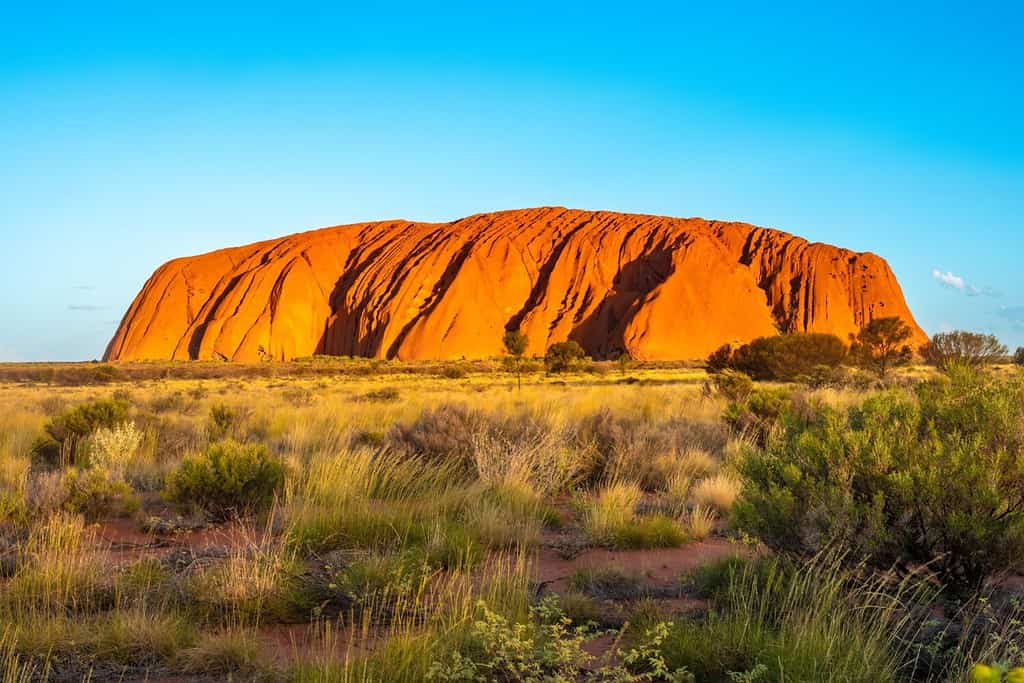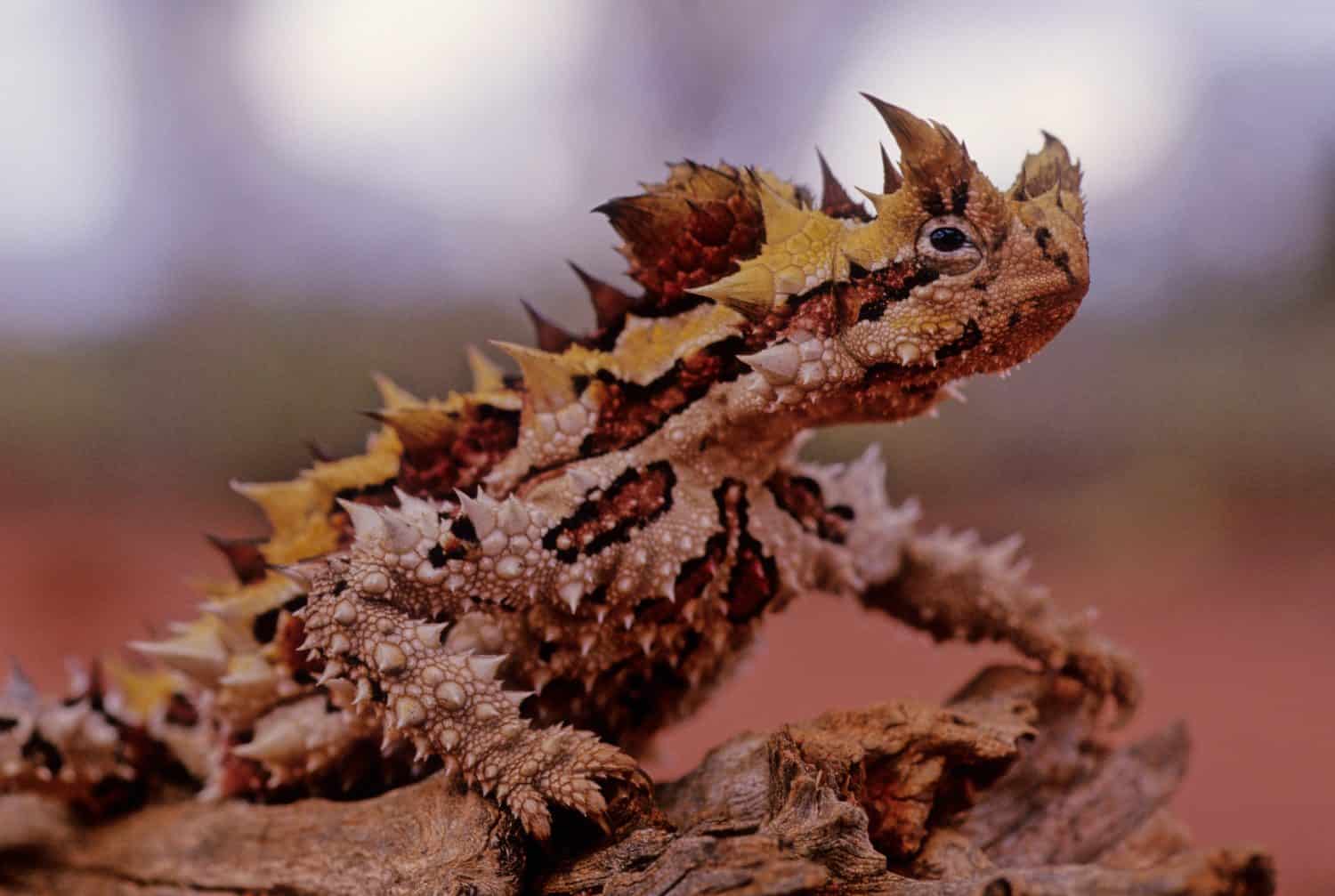Ayers Rock is the most famous landmark in all of Australia. The massive red rock rises from the center of the Australian desert at about 1,142 feet high. The rock is even larger in width — an astounding 5.8 miles in circumference.
Uluru is sacred to the Aboriginal people. They say you can still see signs of the original ancestral creators around the rock.
The Anangu Aboriginal people have been living around the rock for at least 30,000 years. We know they have been in the area for that long due to the carbon dating of the rock art.
The Anangu believe they are descendants of their ancestral beings. They feel they are responsible for the land, the animals that live there, and the visitors.
Uluru is sacred to the Anangu people. So, some areas and knowledge are off-access for those outside the culture.
Although Ayers Rock is sacred, tourists are still allowed to visit. The locals simply ask that visitors respect the rock and the surrounding areas.
Many visitors flock to Uluru to see the beautiful landscapes and surrounding trails. It is also the perfect place to learn about Australia’s Aboriginal history.
How the Rock got its Name

Uluru Rock is a massive formation that rises above Australia’s desert landscape.
©LouieLea/Shutterstock.com
Australia’s Uluru Rock often goes by the name Ayers Rock, which became popular in 1993.
The name “Uluru” comes from the Pitjantjatjar language. The name doesn’t have an English translation, so some began calling it Ayers Rock.
William Gosse named the landmark “Ayers Rock” when he “discovered” it in 1873. We put the word “discovered” in quotations because he didn’t discover it at all. Rather, he was the first non-Aboriginal person to see the rock. The Aboriginals knew of the rock for long before that.
Gosse named the rock after South Australia’s Chief Secretary, Sir Henry Ayers.
People most commonly called the rock “Ayers Rock” between 1873 and 1993. In 1993, the government gave the landmark the dual name of Ayers Rock/Uluru. In 2002, they switched the names so that the dual name became Uluru/Ayers Rock.
The Story of Uluru’s People

Many caves and crevices dot Uluru Rock and are home to thousands of birds.
©LouieLea/Shutterstock.com
One story tells how people came to live near Uluru. The Mala people originally lived up north but came upon this rock and decided to stay to hold a ceremony.
Two Wintalka Men invited the Mala people to attend their ceremony. The Mala people said they couldn’t go because their ceremony had begun. The Wintalka people were angry when the Mala people did not come to celebrate with them. They created Kurpany — a massive, evil devil-dog spirit.
A kingfisher woman named Luunpa saw the spirit coming and tried to warn the Mala people. They didn’t believe her, which led to the deaths of several men. The people ran from the spirit and began living south of the rock.
The Aboriginals believe Luunpa’s spirit still watches over the area and the people. Luunpa is believed to be a large rock now.
Go Hiking at Uluru

You can walk for 6.2 miles around the base of Uluru.
©iStock.com/phastflyer
Many paths lead to and from the rock, which are said to follow the steps of the ancestral beings.
There are six walks you can take at Uluru, listed below:
- Uluru Base Walk: 6.2 miles long and goes around the base of the entire rock.
- Mala Walk: hike from the Mala carpark to Kantju Gorge and explore the historical caves and rock art.
- North-East Face Walk: travel the longest span of the Uluru Base Walk. Learn the creation stories in person.
- Pictures are prohibited in this area, so visiting is the only way to experience it.
- Kuniya Walk and Mutitjulu Waterhole: this is the shortest walk and is home to many plants and shade. Visit this trail during the rainy season to experience beautiful waterfalls.
- Lungkata Walk: this is where you’ll see the most on your trip. The Lungkata Walk is home to elevated crevices and caves where thousands of birds live.
- Liru Walk: this walk is the least traveled, used mainly by cyclists. Stop by the shelter at the center of the hike to get magnificent views of the rock.
You can also drive 31 miles to see Kata Tjuta’s domes — another beautiful and famous landmark. The name Kata Tjuta comes from the Pitjantjatjara language. It means “many heads” because it has 36 domes.
Once you reach Kata Tjuta, you must explore the site by foot. Please respect the area and stick to the paths.
The Best Places to See Sunsets at Uluru
Officials say the best time to visit Uluru is at sunrise and sunset. The waxing and waning sunlight brings out the natural colors of the rock.
There are five areas within the park designated for viewing the sunset and sunrise:
- Talinguru Nyakunytjaku
- Kata Tjuta dune viewing area
- Kata Tjuta sunset viewing area
- Uluru car sunset viewing area
- Uluru bus sunset viewing area
These areas are perfect for viewing sunsets and sunrises. The park positioned them so you can view the rock when the sun hits it at a particular angle. Those angles cause the rock to look like it’s changing color.
Other Things to Do in the Park
Consider participating in a free ranger-guided activity to get the most out of your visit. The rangers will educate you about Uluru’s history, culture, and biology. They do all this while ensuring you have fun. Enjoy a guided walk, bush tucker talk, or Cultural Centre presentations.
Visit the Cultural Centre to enjoy free presentations and exhibits. Check out the art galleries featuring Aboriginal art. You can also buy goodies at the shops owned by community members.
The Animals and Plants of Uluru

Thorny devils live in the harsh environment of the Australian desert.
©Roberto Dani/Shutterstock.com
Ayers Rock is home to many unique plant and animal species, like Wallabies and river red bum trees. Although the rock sits in the center of a desert, the area is suitable for much life.
Take a walk along the Kuniya walk and Mutitjulu Waterhole trail. You’re likely to catch a glimpse of many of the area’s plants and wildlife. Besides Wallabies and river red gum trees, you can see some of the foods the Aboriginals used to eat. These crops include bush tomatoes, bush plums, and figs.
Most of the plants were essential for food, medicine, and tools. Some of the plants include:
- Blue mallee
- Desert bloodwood
- Desert quandong
- Honey grevillea
- Striped mintbush
The animals have had to adapt to the harsh desert environment to survive. Some of these animals include:
- Brown falcon
- Grey-headed honeyeater
- Pied butcherbird
- Blue tongue lizard
- Thorny devil
- Woma python
- Dingo
- Red kangaroo
- Southern marsupial mole
Experience the Rock Art

Rock art at Uluru dates back to at least 10,000 years.
©Mussa Regagda/iStock via Getty Images
The rock art around Uluru shows how the Aboriginals passed down stories from generation to generation.
Many sites around the rock have been used for tens of thousands of years. Many paintings were created on top of one another.
The Anangu people used the rock for education, using the surface like a chalkboard. Today, they still use the old artwork to teach others the creation stories. Yet, they rarely create new paintings.
The best places to see rock art include Kulpi Mutitjulu and Kulpi Nyiinkaku — the teaching cave.
Can You Climb Uluru?
Climbing Uluru was legal until October 26, 2019, when the government officially banned it.
The Anangu people do not wish for visitors — or anyone — to climb Uluru, so it is prohibited.
Uluru is significant in their culture. Their traditional law does not allow climbing. They ask that visitors respect their wishes and don’t climb the rock.
The locals also feel personally responsible for the land, wildlife, and visitors. Climbing the rock would be dangerous, so they ask for no climbing for safety reasons.
The rock is notoriously steep and has caused climbers to get stuck or injured. Some have even died trying to climb. Rangers frequently saved those who got stuck on the rock when it was open to climbing.
Climbing also hurts the rock. Many years of climbing have caused irreversible erosion. The erosion has also made the rock’s surface slippier and more dangerous for climbing.
The photo featured at the top of this post is © LouieLea/Shutterstock.com
Thank you for reading! Have some feedback for us? Contact the AZ Animals editorial team.






